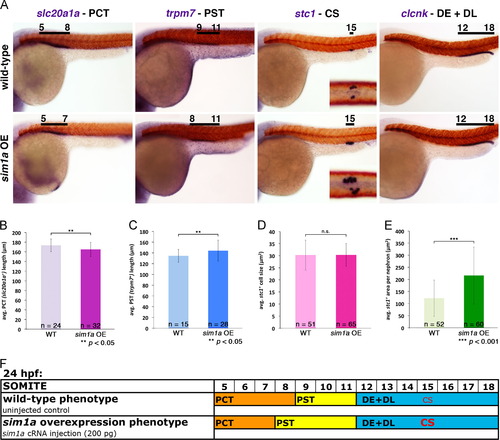Fig. 4
- ID
- ZDB-FIG-150416-10
- Publication
- Cheng et al., 2015 - Nephron proximal tubule patterning and corpuscles of Stannius formation are regulated by the sim1a transcription factor and retinoic acid in zebrafish
- Other Figures
- All Figure Page
- Back to All Figure Page
|
sim1a overexpression is partially sufficient to promote the PST and CS while inhibiting PCT fate. (A) Wild-type embryos injected with 200 pg of sim1a cRNA were assayed by WISH at 24 hpf with specific kidney segment markers, (purple), and with smyhc1 to demarcate the somites (red). Black lines indicate segment domains relative to somite numbers. Embryo anterior is to the left. Quantitative analyses utilizing the two-tailed Studentós t-test were performed to assess changes in the expression domains of (B) slc20a1a, (C) trpm7, (D) the size of individual stc1+ CS cells and (E) the size of the stc1+ area. (F) Summary of the sim1a overexpression phenotype. Colored bars indicate segment domains in relation to the corresponding somite numbers indicated above. Abbreviations: cRNA – capped RNA; CS – corpuscles of Stannius; DE – distal early; DL – distal late; hpf – hours post fertilization; OE – overexpression; PCT – proximal convoluted tubule; PST – proximal straight tubule; WISH – whole mount in situ hybridization. |
Reprinted from Developmental Biology, 399(1), Cheng, C.N., Wingert, R.A., Nephron proximal tubule patterning and corpuscles of Stannius formation are regulated by the sim1a transcription factor and retinoic acid in zebrafish, 100-16, Copyright (2015) with permission from Elsevier. Full text @ Dev. Biol.

